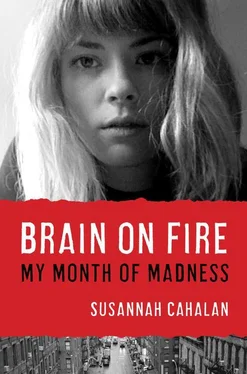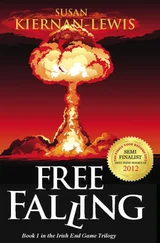“What will these all do?” my mother asked.
“It’s a three-pronged attack, no stoned turned,” Dr. Najjar said, missing the English idiom. “We’re going to reduce the body’s inflammation with steroids. Then flush the body of the antibodies with plasmapheresis, and further reduce and neutralize the antibodies with IVIG. It leaves no room for error.”
“When will she be able to go home?” my dad asked.
“As far as I’m concerned, she could leave tomorrow,” Dr. Najjar replied. “The steroids could be taken orally. She could return to the hospital for plasma exchange, and the IVIG treatment, if the insurance company approved it, could be done with a nurse at home. With all these treatments I believe that it’s likely Susannah will get back to 90 percent.”
Though I don’t remember the diagnosis, my parents tell me that when I heard this my demeanor changed, and I seemed bolstered by the news that I would be returning home soon. Dr. Russo noted in my chart that I appeared “brighter,” my speech “improved.”
Home. I was going home.
The next morning, Saturday, April 18, I was finally discharged. I had been in the hospital for twenty-eight days. Many of the nurses—some of whom had washed me, others who had injected me with sedatives, and a few of whom had fed me when I could not feed myself—came to say their good-byes. Nurses seldom find out how a patient fares after she leaves the hospital, and I was still in a particularly bad place. A small, hunched-over man entered the room holding papers. He had secured an at-home nurse to tend to me and had recommended a clinic where I could receive full-time rehab. My mother took the papers, but only absentmindedly flipped through them; she would address these later. For now, we were going home, and that was all that mattered.
My mom, my dad, Allen, Stephen, and my college friend Lindsey, who had flown in from St. Louis the day before, all grabbed my possessions—stuffed animals, DVDs, clothes, books, and toiletries—and crammed them in clear plastic NYU “Patient’s Belongings” bags; they left behind the flowers and magazines. A transport staff worker helped me into a wheelchair as my mom placed slip-on flats on my feet. It was the first time I had worn shoes in a month.
The night before, my dad had made a sign thanking the nurses for their support. He posted it near the elevators:
THANK YOU
On behalf of our daughter Susannah Cahalan, we would like very much to thank the entire staff of the epilepsy floor at NYU Medical Center. We came to you with a difficult and desperate situation, and you responded with skill and compassion. Susannah is a wonderful young woman who deserved your hard work. Her mother and I will forever be in your debt. I cannot think of more meaningful work than what you do every day.
Rhona Nack Tom Cahalan

My prognosis was still unclear—the projection was only “fair”—and no one could say with any certainty if I would ever get to that optimistic “90 percent,” or if I would ever regain any semblance of my former self. But they had a plan. First, I would continue to see Dr. Najjar every other Wednesday. Second, I would get a full-body positron emission tomography scan (PET scan) that creates a three-dimensional image of the body, which is different from MRIs and CT scans because it shows the body in the process of functioning. Third, I would be enrolled in cognitive and speech rehabilitation, and they would arrange for a twenty-four-hour nurse to care for me. Fourth, I would take oral steroids, receive plasma-exchange treatment, and get several more infusions of IVIG. But the doctors were aware that even months after the disease has run its course and immunosuppressants have been worked into the system, antibodies can still persist, making recovery a painful march of two steps forward, one step back.
They gave my mother a list of the medications I would now be taking: prednisone; Ativan, an antianxiety drug used to treat and prevent signs of catatonia; Geodon for psychosis; Trileptal for seizures; Labetalol for high blood pressure; Nexium to deal with the acid reflux caused by the steroids; and Colace for the constipation caused by the combination of all the drugs. Still, in the back of everyone’s mind was that 4 percent mortality figure. Even with all of this, with all the proper intervention, people still died. Sure, they had a name for my illness and actions we could all take, but there was still a long uncertain journey ahead.
Stephen, Lindsey, and I filed into Allen’s Subaru. When I had been admitted in early March, it was still winter; now it was springtime in New York. We drove back to Summit in silence. Allen turned on the radio, tuning it to a local lite FM station. Lindsey looked over at me to see if I recognized the song.
“Don’t go breaking my heart,” a man’s voice started.
“I couldn’t if I tried,” a woman’s voice returned.
This had been my go-to karaoke song in college in St. Louis. At this point, Lindsey doubted I would remember it.
I began bopping my head out of rhythm, my arms at rigid right angles. I swung my elbows front to back like I was awkwardly cross-country skiing. Was this one of my weird seizure-like moments, or was I dancing to an old favorite? Lindsey couldn’t tell.
My mom’s house in Summit looked particularly striking that spring day, my homecoming. The front lawn was lush with fresh green grass, white azaleas, and the blooms of pinkish-purple rhododendrons and yellow daffodils. The sun beamed down on the aged oak trees that shaded the maroon door at the entranceway to the stone-front colonial. It was gorgeous, but no one could tell if I even noticed. I certainly don’t remember it. I just stared ahead, making that constant chewing motion with my mouth as Allen swerved into the driveway of the place I had called home most of my young adult life.
The first thing that I wanted to do was take a real shower. There were still clumps of glue in my scalp that looked like pebble-sized pieces of dandruff, and I still had the metal staples from the surgery, so I could not be too vigorous with my washing. My mother offered to help, but I refused, determined to do this small thing on my own, at last.
After a half hour, Lindsey headed upstairs to check on me. Through the opening in my bedroom door, she could see me sitting on the bed, freshly showered, with my legs flexed rigidly off the side, fidgeting with the zipper on my black hoodie. I was struggling to connect the zipper with the pull. Lindsey watched for a moment, unsure of what to do; she didn’t want to embarrass me by knocking on the door and offering aid, because she knew I didn’t like to be babied. But when she saw me go limp, drop the zipper, and begin to sob out of frustration, she headed into the room. She sat down beside me and said, “Here, let me help,” zipping up my hoodie in one fluid motion.
. . .
Later that evening, Stephen cooked a pasta dinner as a quiet celebration for my return. Allen and my mom left the house so that the three of us could have some alone time. My mother was so relieved that they finally had a name for what ailed me that she had truly convinced herself the worst was behind us.
After dinner, we sat outside on the back patio. Lindsey and Stephen made small talk while I stared ahead, as if I didn’t hear them. But when they lit cigarettes, I got up without a word and walked inside.
“Is she okay?” Lindsey asked.
“Yes, I think she’s just adjusting. We should give her a moment alone.”
They are smoking together. Who knows what else they’ll do together.
Читать дальше













